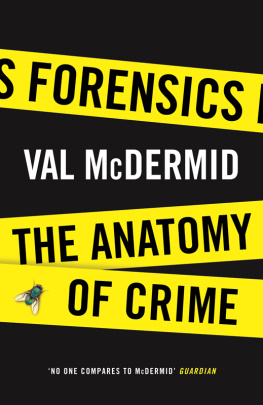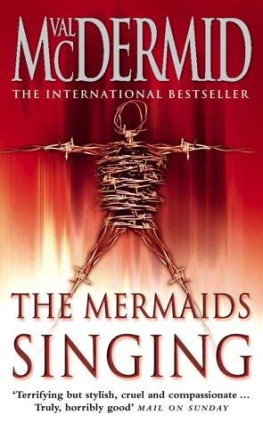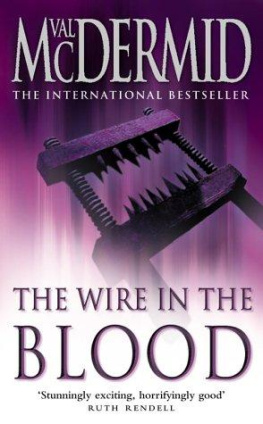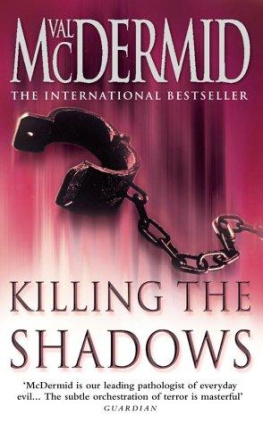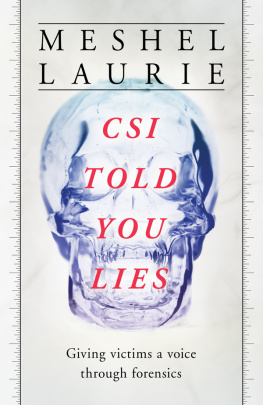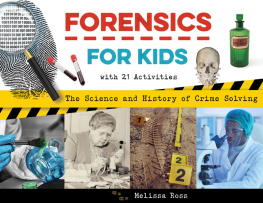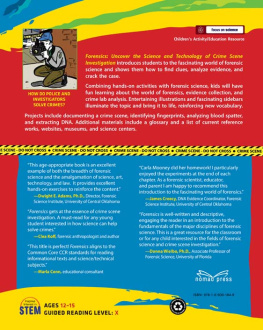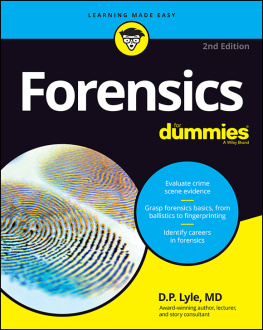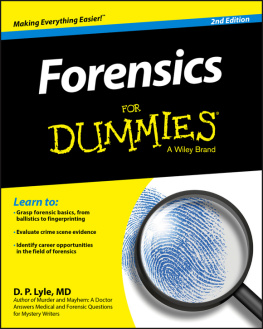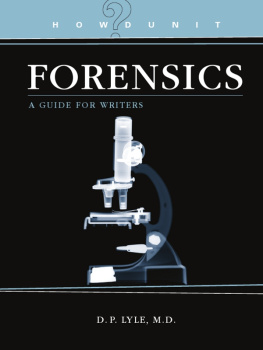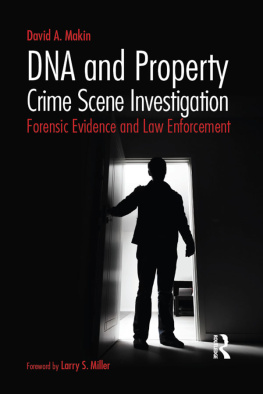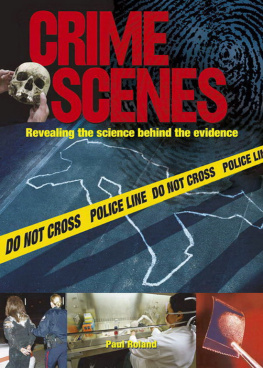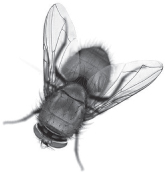
VAL McDERMID has published twenty-eight crime novels, which have sold millions of copies worldwide, been translated into sixteen languages and won multiple awards. Her series featuring criminal profiler Tony Hill was the basis for the TV series The Wire in the Blood for ITV.

FORENSICS
THE ANATOMY OF CRIME
VAL McDERMID

First published in Great Britain in 2014 by
PROFILE BOOKS LTD
3A Exmouth House
Pine Street
London EC1R 0JH
www.profilebooks.com
Published in association with Wellcome Collection for the exhibition Forensics: The Anatomy of Crime, curated by Lucy Shanahan and Shamita Sharmacharja.

Wellcome Collection is a free visitor destination for the incurably curious.
It explores the connections between medicine, life and art in the past, present and future. Wellcome Collection is part of the Wellcome Trust, a global charitable foundation dedicated to achieving extraordinary improvements in human and animal health.
Wellcome Collection
183 Euston Road
London NW1 2BE
www.wellcomecollection.org
Copyright Val McDermid, 2014
Wellcome content copyright The Wellcome Trust, 2014
10 9 8 7 6 5 4 3 2 1
The moral right of the author has been asserted.
All rights reserved. Without limiting the rights under copyright reserved above, no part of this publication may be reproduced, stored or introduced into a retrieval system, or transmitted, in any form or by any means (electronic, mechanical, photocopying, recording or otherwise), without the prior written permission of both the copyright owner and the publisher of this book.
A CIP catalogue record for this book is available from the British Library.
Hardback ISBN 978 1 78125 3199
Export ISBN 978 178125 1690
eISBN 978 184765 9903
Printed and bound in Great Britain by Clays, Bungay, Suffolk

For Cameron, with love
Without science, there would be no you;
without you, the future would offer a much narrower prospect.
Good stuff, science.

PREFACE
T he face of justice we know today has not always been judicious. The notion that the criminal law should be based on evidence is a relatively recent one. For centuries, people were accused and found guilty because of their lack of status; because they werent from round here; because they or their wife or their mother was handy with herbs; because of the colour of their skin; because they had sex with an inappropriate partner; because they were in the wrong place at the wrong time; or just because.
What changed that was the growing understanding that the scene of a crime held all sorts of useful information and that branches of science were emerging which could read that information and present it in a courtroom.
The trickle of eighteenth-century scientific discoveries that turned into a flood in the nineteenth century and beyond soon found practical applications far beyond the laboratory bench. The idea of proper criminal investigation was just beginning to take hold, and some of those early detectives were eager to find evidence that would back up their theories of the crimes they were investigating.
Forensic meaning, a form of legal evidence science was born. And it soon became clear that many branches of scientific inquiry would have something to contribute to this new methodology.
One of the earliest examples brought together pathology and what we would now call document examination. In 1794, Edward Culshaw was murdered with a pistol shot to the head. Back then, pistols were muzzle-loaded and a wad of crushed paper was tamped down to secure the balls and the powder in the gun. When the surgeon examined the body, he found the wad inside the head wound. He opened it up and it was revealed to be the torn corner of a ballad sheet.
The murder suspect, John Toms, was searched. In his pocket was a ballad sheet, the torn corner of which matched exactly the pistol wad. At his trial in Lancaster, Toms was convicted of murder.
I can only imagine how exciting it must have been to see these developments making the law a more certain instrument of justice. The scientists were helping the courts turn suspicion into certainty.
Take poison, for example. For hundreds of years, poison had been the murder method of choice. But, without reliable toxicology tests, it was almost impossible to prove. That was about to change.
But even in the earliest stages, that scientific evidence was open to question. In the late eighteenth century, a test had been devised to detect arsenic, but only in large quantities. Later, the test was refined to become more effective, thanks to the British chemist James Marsh.
In 1832, the prosecution called on him as an expert witness in chemistry during the murder trial of a man accused of poisoning his grandfather using arsenic in a cup of coffee. Marsh had conducted his test on a sample of the suspicious coffee and had demonstrated the presence of arsenic. But when he came to show it to the jury, the test sample had deteriorated, the result no longer clear. The accused walked free on the grounds of reasonable doubt.
But this wasnt a setback for the fledgling experts. James Marsh was a proper scientist. He regarded this failure as a spur towards success. His response to the embarrassment of his court appearance was to devise a better test. His definitive test was so effective it could detect even a tiny trace of arsenic; it was ultimately responsible for the hanging of many a Victorian poisoner who had reckoned without forensic science. And its still in use today.
The story of forensic science, of that road from crime scene to courtroom, is the stuff of thousands of crime novels. The application of science to the solving of crime is the reason I am gainfully employed. Not for the obvious reason that forensic scientists are generous with their time and their knowledge but because their work has transformed what happens in courtrooms all round the world.
We crime writers sometimes like to claim our genre has its roots in the deepest recesses of literary history. We claim antecedents in the Bible: fraud in the Garden of Eden; fratricide by Cain of Abel; the manslaughter of Uriah by King David. We try to convince ourselves that Shakespeare was one of us.
But the truth is that crime fiction proper only began with an evidence-based legal system. And that is what those pioneering scientists and detectives bequeathed us.
It was clear, even in the early days, that while science could help the courts, so the courts could push scientists on to greater heights. Both sides have a key role to play in the delivery of justice. For this book, I have spoken to leading forensic scientists about the history, the practice and the future of their disciplines. I have climbed to the pinnacle of the highest tower in the Natural History Museum in pursuit of maggots; I have been transported back to my own confrontations with sudden violent death; I have held somebodys heart in my hands. Its been a journey that has filled me with awe and respect. The stories these scientists have to tell us about that often tortuous journey from crime scene to courtroom are among the most fascinating you will ever read.
Next page
